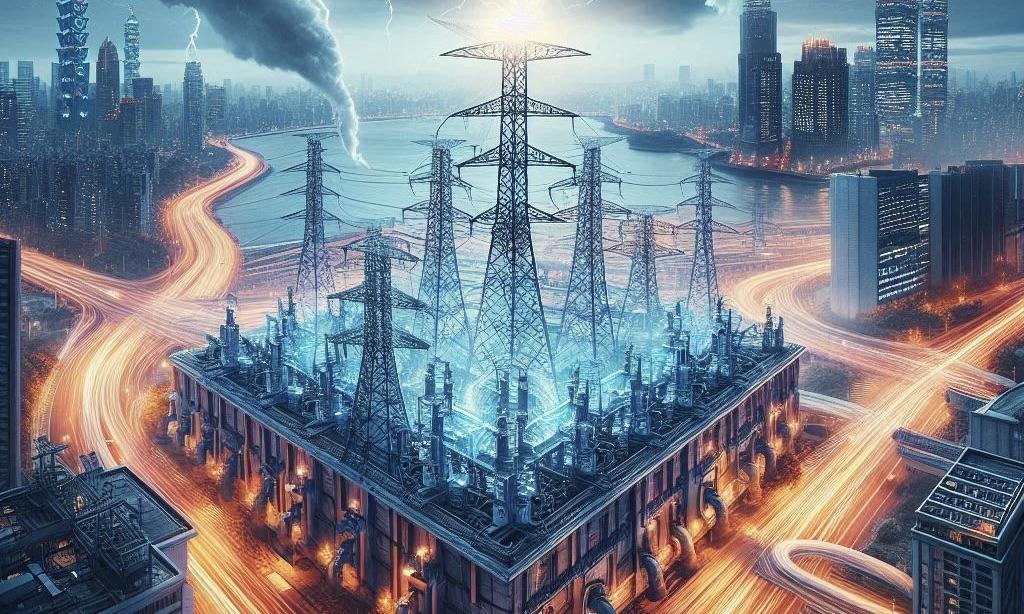TSMC’s rising electricity demand, driven by its advanced 3-nanometer chip production, could significantly strain Taiwan’s energy infrastructure by 2030, according to a report from S&P Global Ratings. The semiconductor giant’s consumption may reach nearly a quarter of the nation's total electricity, posing risks to the country's energy reserves
S&P Warns TSMC’s Growing Electricity Demand Could Strain Taiwan’s Energy
According to a recent report from S&P Global Ratings, the Taiwan Semiconductor Manufacturing Company (TSMC) is facing a pressing issue of increasing credit risks due to its substantial electricity consumption. TSMC, Taiwan's most valuable firm in terms of market capitalization, is a significant electricity consumer, contributing to approximately 8% of the nation's total electricity consumption. The firm's increased production of advanced 3-nanometer circuits is the cause of this surge in demand. In 2023, each wafer unit consumed 40.5-kilowatt hours of electricity, highlighting the situation's urgency.
The government's objective of maintaining a 15% electricity reserve is being seriously challenged by Taiwan's state-owned electricity provider, TaiPower, which is experiencing a significant increase in power consumption. The company's substantial influence on the nation's energy infrastructure is further underscored by Taiwan's decreasing residential electricity consumption despite TSMC's increasing energy requirements. This situation could strain Taiwan's energy infrastructure, emphasizing the gravity of the situation.
TSMC’s Electricity Use Could Reach 24% of Taiwan’s Power Supply by 2030, S&P Report Predicts
According to data from S&P, TSMC's electricity consumption has increased by over twofold since the company transitioned from the production of 10-nanometer chips in 2016 to its present production of 3-nanometer chips in 2023. TSMC consumed approximately 110 GW of electricity in 2016, approximately 4% of Taiwan's total electricity consumption. By 2023, this figure had increased to nearly 250 GW, contributing to almost 16% of the industrial sector's demand and 8% of Taiwan's electricity.
S&P's analysis presents a more concerning scenario for TSMC's energy consumption in the future. The report's optimistic projection indicates that TSMC could be responsible for nearly a quarter (23.7%) of Taiwan's electricity consumption by 2030 if the company's wafer shipments increase by 90% over 2023, resulting in a 794 GW increase in electricity consumption. Consumption would reach 418 GW by 2030 in a less aggressive scenario, with 50% growth.
TSMC’s Shift to 3-Nanometer Chip Production Drives Soaring Power Consumption, Exceeding Global Competitors
The primary factor contributing to TSMC's increasing energy requirements is the transition to 3-nanometer chip fabrication. To meet the technical specifications for producing chips with a diameter of less than 7 nanometers, extreme ultraviolet (EUV) lithography machines must be used. Wccftech says these machines require substantially more power than their deep ultraviolet (DUV) counterparts. Each 12-inch wafer consumed 27.7 KW when TSMC commenced mass production of 3-nanometer processors in 2022. As production increased, this figure increased to 40.5 KW by 2023.
TSMC's electricity consumption has also increased due to the increasing demand for AI processors. The increased packaging capacity for AI-related processors, essential for performance-intensive GPUs, further strains Taiwan's already limited electricity reserves. Despite a decrease in household electricity demand during this period, Taiwan has needed help maintaining its 15% electricity reserve objective, achieving it in three years from 2013 to 2023.
In contrast, TSMC's electricity consumption is significantly higher than its global competitors. According to sustainability reports analyzed by S&P, TSMC consumed 232 GW of electricity in 2023, more than double Intel's 90 GW and substantially more than SK hynix's 125 GW. This highlights the need for a balanced approach to energy consumption, ensuring sustainability while meeting the growing demand.



 EU Court Cuts Intel Antitrust Fine to €237 Million Amid Long-Running AMD Dispute
EU Court Cuts Intel Antitrust Fine to €237 Million Amid Long-Running AMD Dispute  Moore Threads Stock Slides After Risk Warning Despite 600% Surge Since IPO
Moore Threads Stock Slides After Risk Warning Despite 600% Surge Since IPO  Apple App Store Injunction Largely Upheld as Appeals Court Rules on Epic Games Case
Apple App Store Injunction Largely Upheld as Appeals Court Rules on Epic Games Case  noyb Files GDPR Complaints Against TikTok, Grindr, and AppsFlyer Over Alleged Illegal Data Tracking.
noyb Files GDPR Complaints Against TikTok, Grindr, and AppsFlyer Over Alleged Illegal Data Tracking.  Australia Enforces World-First Social Media Age Limit as Global Regulation Looms
Australia Enforces World-First Social Media Age Limit as Global Regulation Looms  Evercore Reaffirms Alphabet’s Search Dominance as AI Competition Intensifies
Evercore Reaffirms Alphabet’s Search Dominance as AI Competition Intensifies  SpaceX Insider Share Sale Values Company Near $800 Billion Amid IPO Speculation
SpaceX Insider Share Sale Values Company Near $800 Billion Amid IPO Speculation  Trump Signs Executive Order to Establish National AI Regulation Standard
Trump Signs Executive Order to Establish National AI Regulation Standard  SK Hynix Considers U.S. ADR Listing to Boost Shareholder Value Amid Rising AI Chip Demand
SK Hynix Considers U.S. ADR Listing to Boost Shareholder Value Amid Rising AI Chip Demand  SoftBank Shares Slide as Oracle’s AI Spending Plans Fuel Market Jitters
SoftBank Shares Slide as Oracle’s AI Spending Plans Fuel Market Jitters  Trello Outage Disrupts Users as Access Issues Hit Atlassian’s Work Management Platform
Trello Outage Disrupts Users as Access Issues Hit Atlassian’s Work Management Platform  Microsoft Unveils Massive Global AI Investments, Prioritizing India’s Rapidly Growing Digital Market
Microsoft Unveils Massive Global AI Investments, Prioritizing India’s Rapidly Growing Digital Market  China Adds Domestic AI Chips to Government Procurement List as U.S. Considers Easing Nvidia Export Curbs
China Adds Domestic AI Chips to Government Procurement List as U.S. Considers Easing Nvidia Export Curbs  Apple Explores India for iPhone Chip Assembly as Manufacturing Push Accelerates
Apple Explores India for iPhone Chip Assembly as Manufacturing Push Accelerates  SpaceX Begins IPO Preparations as Wall Street Banks Line Up for Advisory Roles
SpaceX Begins IPO Preparations as Wall Street Banks Line Up for Advisory Roles  iRobot Files for Chapter 11 Bankruptcy Amid Rising Competition and Tariff Pressures
iRobot Files for Chapter 11 Bankruptcy Amid Rising Competition and Tariff Pressures  SUPERFORTUNE Launches AI-Powered Mobile App, Expanding Beyond Web3 Into $392 Billion Metaphysics Market
SUPERFORTUNE Launches AI-Powered Mobile App, Expanding Beyond Web3 Into $392 Billion Metaphysics Market 






























